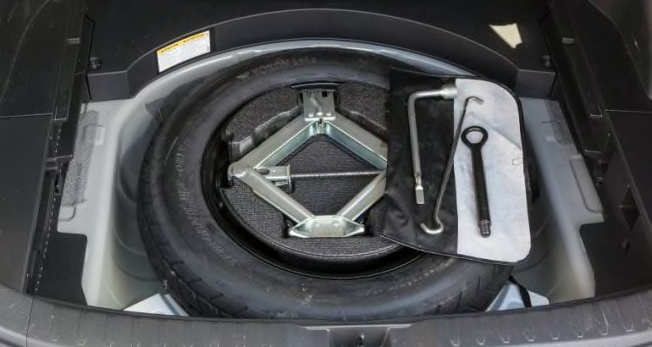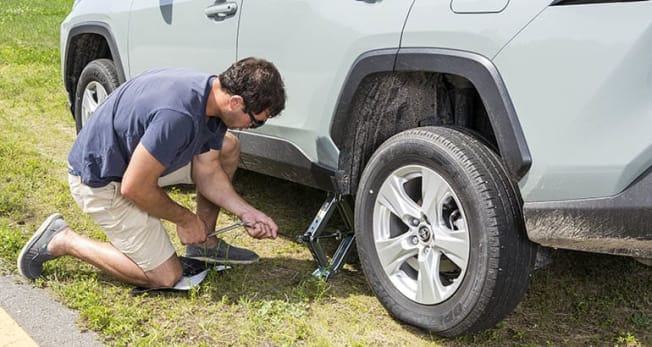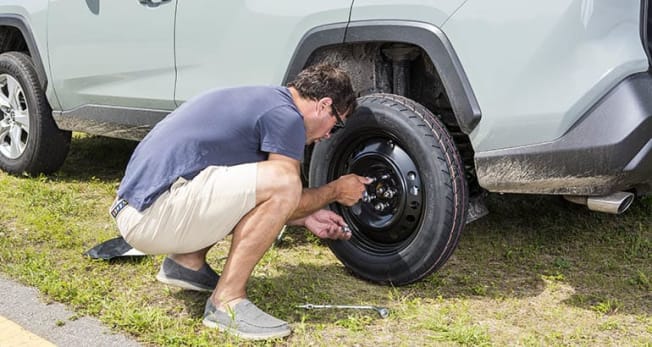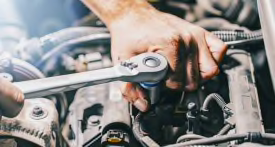How to Change a Car Tire
Tips to make an unpleasant roadside task safe and easy
Many drivers dread being stuck on the side of a road with a flat tire. It can leave them stuck in a dangerous spot or a remote location where help isn’t readily available. Here, we explain what to do if you experience this common problem.
For most people, the best response is to contact a roadside assistance service such as AAA or the service provided by the car’s manufacturer. And many drivers do just that. AAA responds to over 3.5 million calls about flat tires a year, underscoring how common flats are.

Consumer Reports Consumer Reports
What to Do If Your Tire Goes Flat
- If you hit something in the road that causes a complete blowout, or loss of air, the vehicle will pull in the direction of that tire. The effect is immediate. A gradual air leak will take longer to be noticed, but it will ease into this same pulling effect.
- Keep both hands on the wheel, and ease off the accelerator. All of your driving inputs—braking, steering, or acceleration—should be gentle and deliberate.
- When you notice the flat, pull over as soon as possible at a safe, flat location. Move as far from the travel lanes of the roadway as possible. Be aware of traffic moving around you. Above all: Don’t panic.
- If you’re in a spot where you can’t immediately pull over, such as on a bridge or along a narrow road, put on your hazard lights using the red triangular button on the dash, move to the roadside, and limp the car to a safer area. You can roll on the tire for a short distance, but it can further deteriorate and you might damage the wheel. Still, that may be your only option to get to a safe place to stop. A breakdown lane or roadside shoulder can work, but a rest stop or a parking lot is even better.
- Leave your hazard lights on if you’re stopped near moving vehicles. These lights will warn other motorists that you have a serious mechanical problem.
- Be careful opening your door, especially if you’re near traffic. Be safe by being calm and deliberate with your actions; don’t get caught up in the moment.
- Set up reflective traffic triangles behind your vehicle. Place them further away on high-speed roads, about 100 feet behind you. At highway speeds, cars may travel 100 feet in the blink of an eye.
- Inspect the tire. Is it a puncture or sidewall tear? Either way, it needs to be replaced, but knowing the cause of your flat tire may have an impact on your replacement strategy.
- Do you have a compact or full-sized spare? If you have a spare of either size, and you’re comfortable with the task, replace the flat tire. If you have just an inflation kit (typically a pressurized air canister with a sealant), as is increasingly common on new cars, be aware that these are designed to temporarily fix punctures, but they can’t patch a sidewall tear.
- If you are waiting for help, don’t sit in the car or stand in front of it. Both places are perilous should another car strike yours. Instead, stay further off the road behind the vehicle.

Consumer Reports Consumer Reports
How to Change a Car Tire
- The car needs to be on level, solid ground in order for you to safely use the jack. Carrying a small wooden board in the trunk can help create a solid flat surface when the tire has to be changed on dirt.
- Turn on your hazard lights. (Yes, this important tip bears repeating.)
- Put the car in Park (for an automatic transmission) or in gear (manual transmission). Then set the parking brake.
- Get out the owner’s manual and review the procedure for changing the tire. Even though you have practiced this, you are in a stressful situation. Take your time to make sure it doesn’t become dangerous.
- Get out the spare tire, jack, and needed tools. Everything should be in the trunk or cargo area. With trucks, minivans, and some SUVs, the tire may be stored under the vehicle and will need to be lowered down.
- Use a floor mat to make a more comfortable area to kneel upon while you’re changing the tire.
- Remove the wheel cover, if there is one. The owner’s manual will tell you if it merely pops off or if there are plastic nuts that need to be undone.
- Loosen but don’t remove the lug nuts with the tire iron, turning counterclockwise, before you begin jacking up the car (shown above). Some cars with alloy wheels have a locking lug nut that requires a special keyed lug socket to remove it. The socket is usually located with the spare tire or in the glove box.
- Jack up the car (shown below). Position the jack under the specific point of the vehicle’s body as spelled out in the owner’s manual. Follow the instructions to the letter, because if you get it wrong, you may damage the car or risk injury to yourself and others. Lift the side of the car until the flat tire is a few inches off the ground, then remove the lug nuts and flat. You’ll want to make sure you have enough clearance to get the fully inflated tire on in its place. Have the spare tire close by and ready to swap in.
- Install the spare tire. Lightly tighten the lug nuts in a cross pattern—alternating across like you’re drawing a star, rather than sequentially around the circle—so the spare is snug (shown at bottom). Repeat the pattern, securing the wheel so it doesn’t wiggle.
- Lower the jack and remove it from under the car.
- Tighten the lug nuts firmly. Again, do this in a cross pattern.
- Put the flat tire, jack, and tools into the car.
- Pick up your safety triangles. Breathe deep—you did it!
- Drive a few miles and then tighten the lug nuts one more time.
- Compact spares, often referred to as donuts, are only meant to get you to a service station. They have very limited service life and aren’t meant to be used above 50 mph. If you install one, go to a local tire shop that day or the next to buy a proper replacement tire. (Check your owner’s manual regarding mixing a new replacement tire with worn tires. You may need to buy two or four new tires to retain balanced performance.)

Consumer Reports Consumer Reports
How to Avoid Having a Flat Tire
Sometimes a puncture can’t be avoided, but preventative maintenance can help reduce certain risks for a flat tire.
- Check your tire pressure monthly. The correct pressure is indicated on the sticker on the driver’s doorjamb, not the tire’s sidewall. The pressure should be measured before the car is driven that day, because heat can build up in the tire and change its pressure.
- Inspect your tires when you check the pressure, looking for uneven wear, tears, and punctures. You might even avoid a roadside adventure just by following these tips.
- Also check the tire pressure of the spare tire routinely. It does you no good if it’s underinflated or even flat when you need it.
- Just in case, pack an emergency kit in the car with a flashlight and gloves that will make changing a flat tire safer and easier. A bottle of water, a durable snack, and extra clothing can add a bit of comfort.
- Good gear to carry: a small board to assist with using a jack on soft or uneven surfaces, safety triangles to alert other motorists, and a phone charger.

Consumer Reports Consumer Reports
Need a Replacement Tire?
See our tire ratings and buying guide.
















